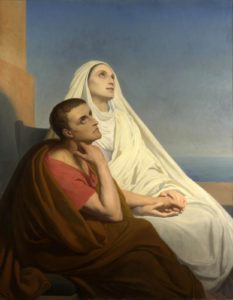Even though she lived more than 1600 years ago, St. Monica faced some of the same problems of today’s women. Her husband had a bad temper. Her mother in-law gave her a hard time. One of her three children caused her heartache with his wayward lifestyle. She could be easily be a twenty-first century woman.
Monica was born in 332 A.D., in what is present-day Algeria. She was a Christian; her husband, Patricius, was a pagan. Stories say that he had a bad temper and may have abused her and been unfaithful to her. He moved his mother into their household, and the two of them apparently gave Monica a hard time on a regular basis.

Monica and her husband had two boys and a girl. Her daughter, Perpetua, entered religious life and went on to be an abbess. Her son, Navigius, went on to be a bishop. But her other more famous son, Augustine, caused his mother much stress and tears for years with his sinful lifestyle. As a boy, Augustine was seriously ill, and Monica attempted to have him baptized. His father gave permission, but later withdrew it when the boy recovered.
Augustine grew up to be smart, but sinful. He began studying the Manichaean religion, which denied the omnipotence of God; this led to many clashes with his mother.
Legend says that Monica wept every day over her son; for 17 years, she wept and prayed. During this time, she consulted a bishop who reassured her “the child of those tears shall never perish.”
Augustine continued to rebel and tried to get away from Monica. He ran away to Rome to live; she set out to meet him there. When he found out she was coming, he fled to Milan.
Monica refused to give up on him. Eventually she led Augustine to St. Ambrose in Milan, who was a great influence on him. Augustine converted to Christianity on Easter 387. He was baptized at the Church of St. John the Baptist.
Now reconciled, Monica and Augustine lived together for a time in the Lombardy region of Italy. They set out to travel to Rome, but Monica died on the way in Ostria, on the west coast of Italy. She was buried in the town there, but her body was later moved to the Basilica di Sant’Agostino. When her remains were moved in the 15th century, it is said that miracles occurred in towns where her relics passed through.
Her epitaph was written by Anicius Aucheniu Bassus, a Roman politician. It reads:
“Here the most virtuous mother of a young man set her ashes, a second light to your merits, Augustine. As a priest, serving the heavenly laws of peace, you taught [or, you teach] the people entrusted to you with your character. A glory greater than the praise of your accomplishments crowns you both – Mother of the Virtues, more fortunate because of her offspring.”
Monica was also influential in the conversion of her husband and mother-in-law before their deaths.
St. Monica stands as a timeless example of mothers who never give up on their children.
St. Monica’s feast day is Aug. 27.
She is the patron saint of wives, abuse victims, conversion and mothers.
St. Augutine’s “Confessions” are said to be a love story born from grief about St. Monica. Find out more about it here: https://www.ling.upenn.edu/courses/hum100/augustinconf.pdf
St. Monica Teardrop Masses are offered for those who have fallen away from the Church.
Here’s a great prayer to St. Monica for other mothers whose children have fallen away: https://aleteia.org/2016/12/28/prayer-to-st-monica-help-my-child-turn-to-christ/
And here is a novena to St. Monica: https://gnm.org/prayers-for-parents/st-monica-litany/








